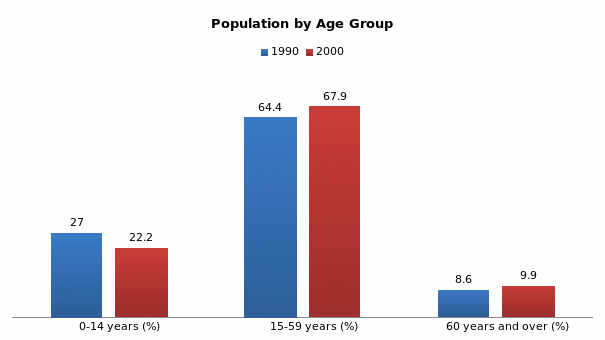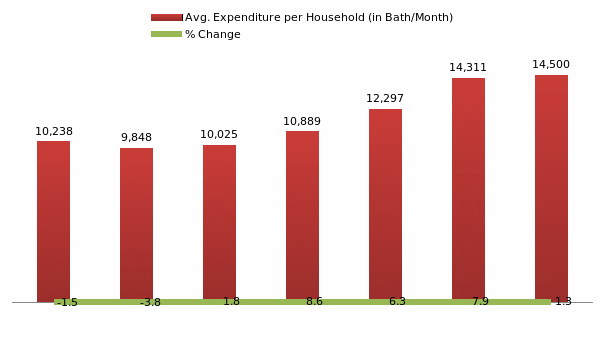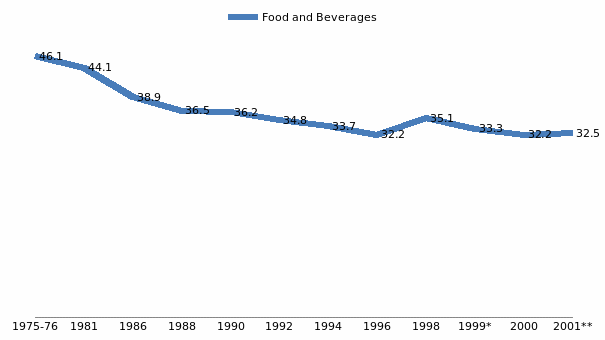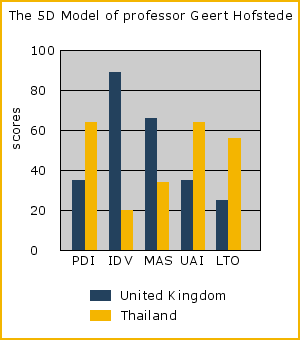Purbeck has an established market for ice cream in the UK. However, with changes in the economic structure of the world, the company has decided to undertake geographic diversification and enter new markets. As Asia is one of the largest and strongest developing markets, the company has decided to enter Thailand. However, cross-cultural marketing considerations must be taken before entering a foreign market.
This report provides a detailed analysis of the consumer trend and cultural aspect of Thailand and provides a comparison of the same for Thailand and the UK. The aim of the paper is to provide a comprehensive understanding of the cultural and consumer behavior differences between the UK and Thailand consumers.
Customer Trend in Thailand
Demographics
Total population of Thailand is 14,215500 in 2000 according to the 2001 census . The population according to the age distribution for 2000 as compared to 1990 census shows that there has been a rise in the working group population from 15 to 59 years, and so has been that of the older population.
However, a decline in the population below 14 years population indicates that the Thailand has a population that is mostly young with average age bring 29.8 years (see figure 1).

Income and Expenditure
The per capita household income in Thailand has been increasing since 1990 through 2007 . The household per capita income in 2007 per month was 18,660 Bath an increase of 4.9 percent from 2006 .
The average per household expenditure of Thailand has shown an increasing trend, though the change per household expenditure has shown a decline in 2000, 2003, and 2007. The income inequality in the household income is high with highest income group having 49.7 percent of total income .

According to 2001 census, the average monthly expenditure of Thailand households on food and beverage was 32.5 percent . The data presented in figure 3 shows a declining share of expenditure on food and beverage in Thailand.

Comparison with the UK
A comparison of the population expenditure of the UK and Thailand showed that Thailand showed that the annual average personal consumption of food and beverage in the UK in 2005 constant dollars was $2802 while that in Thailand was $954 .
The household expenditure in the UK has shown a declining trend in 2009 and 2010 even when there has been an increasing trend in income share of the household during the period . Further, more specifically in case of food items, there is a declining trend in the share of expenditure in Thailand, while that in the US has shown an increasing trend .
Marketing Implications
As the growth of population in Thailand is high and it has a young population, there is evidently a large market for ice cream in the country. However, there is income inequality in the economy, but most of the population lies on the middle class and the upper middle class strata therefore providing a vibrant middle-income group.
Further, the share of household expenditure on food and beverage in the UK has been increasing while that in Thailand has been declining. This demonstrates that the consumer behavior towards food items has been adverse in Thailand, indicating a shrinking of the market for ice cream.
Cultural Dimension in Thailand
Using Hofstede’s cultural dimensions, the cultural outlook of Thailand is determined. Further, this section will also provide a comparison of the former with that of the UK. According to the cultural dimension presented by Holfstede, Thailand has a high ranking of 64 in power distance and uncertainty avoidance . This demonstrates a high inequality of power. However, it is lower than the Asian average of 71.
Moreover, uncertainty avoidance indicates that the society has a low degree of tolerance for uncertainty. Thailand’s society is family oriented and collectivist in nature as the score of individuality index is low. The masculinity ranking of Thailand is 34 is lower than the Asian average of 53 implying that the gender difference in the country is not high.
When the cultural dimensions are compared to that of the UK it is observed that Thailand has much higher power distance than that of the UK, while UK has an individualistic society and Thailand is collectivist in nature. Uncertainty avoidance in Thailand is higher as compared to the UK. Masculinity in the UK is higher as compared to that in the UK.

The above discussion shows that according to Hofstede’s cultural dimensions, the culture of Thailand is very different from that of the UK. The inequality in power distribution in society or that of income is very high in Thailand while that in the UK is low.
On the other hand, UK has a highly individualistic society while that in Thailand is collectivist in nature. Further, uncertainty avoidance being high in Thailand implies that the acceptance of new in low.
The Thai society’s majority population practices Buddhism . This shapes the culture of the country to a great extent. Therefore, selfish craving in the society is low as advocated by the religion. The society is hierarchical in structure, with strong family values. The status within the society is determined through clothes, family name, job, age, etc. The main language spoken in Thailand is Thai.
Business relationship in Thailand flourishes not after one meeting but through continual interactions. Thais prefer non-verbal communication to verbal communication. Rank and hierarchy in office is maintained and respected. It is difficult for Thais to say no, therefore, non-verbal communication should be adopted if any such situation arise.
Marketing implications
The marketing implications for Thailand are that the acceptability for a new foreign product in Thailand may be low initially due to high uncertainty avoidance. Further, due to high power distance, the inequality of income is found to be high, the target customer should be the upper middle class income or above group. Further, the marketing of the product should be targeted towards the family or group rather than to individuals.
Conclusion
Thailand provides a lucrative new market for the ice cream brand, but its culture and consumer behavior is expected to be very different from that of the UK. Therefore the company must be very cautious in adopting a marketing plan in the country that considers the cultural variations of Thailand.
References
ITIM, 2010. Geert Hofstede™ Cultural Dimensions. Web.
Kwintessential, 2010. Thailand – Thai Language, Culture, Customs and Etiquette. Web.
ONS, 2011. Office for National Statistics. Web.
TNSO, 2010. Household Socio-Economic Survey. Web.
TNSO, 2010. National Statistical Office of Thailand. Web.
World Salaries, 2005. Personal Consumption Expenditure – International Comparison. Web.